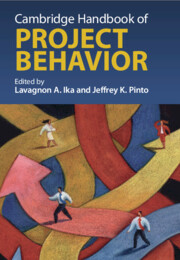Book contents
- Cambridge Handbook of Project Behavior
- Cambridge Handbook of Project Behavior
- Copyright page
- Contents
- Figures
- Tables
- Contributors
- Introduction
- Part I Guiding Principles
- Part II Deviating from Plans
- Chapter 6 Averaging Out Divergent Project Behavior
- Chapter 7 Intra- and Inter-Organizational Governance and the Behavior of Projects
- Chapter 8 Strategic Alignment, Uncertainties, and Realignment of Project Portfolios
- Chapter 9 Stakeholder Perceptions and Project Performance
- Chapter 10 Governance Shifts and Short-term Performance
- Chapter 11 Maximum Feasible Project Failure
- Chapter 12 Project Misbehavior in Infrastructure Projects
- Part III Practical Tips
- Index
- References
Chapter 10 - Governance Shifts and Short-term Performance
from Part II - Deviating from Plans
Published online by Cambridge University Press: aN Invalid Date NaN
- Cambridge Handbook of Project Behavior
- Cambridge Handbook of Project Behavior
- Copyright page
- Contents
- Figures
- Tables
- Contributors
- Introduction
- Part I Guiding Principles
- Part II Deviating from Plans
- Chapter 6 Averaging Out Divergent Project Behavior
- Chapter 7 Intra- and Inter-Organizational Governance and the Behavior of Projects
- Chapter 8 Strategic Alignment, Uncertainties, and Realignment of Project Portfolios
- Chapter 9 Stakeholder Perceptions and Project Performance
- Chapter 10 Governance Shifts and Short-term Performance
- Chapter 11 Maximum Feasible Project Failure
- Chapter 12 Project Misbehavior in Infrastructure Projects
- Part III Practical Tips
- Index
- References
Summary
It is well recognized that the mode of governance adopted for a project can directly impact its performance. Building on previous research on project governance and performance, this chapter seeks to address governance shifts and their effects on (short-term) performance. Three types of governance are reviewed: hierarchical, network and heterarchical, along with their dynamic dimension. Relying on actor-network theory (ANT), the role of the project is explored as a powerful actant. This theoretical and methodological lens enables us to understand shifts in project governance and conceptualize potential impacts on performance, which are discussed both from a proactive and reactive perspective. Lastly, avenues for future research are suggested regarding governance shifts and their impact on performance.
Information
- Type
- Chapter
- Information
- Cambridge Handbook of Project Behavior , pp. 158 - 168Publisher: Cambridge University PressPrint publication year: 2025
References
Accessibility standard: WCAG 2.0 A
Why this information is here
This section outlines the accessibility features of this content - including support for screen readers, full keyboard navigation and high-contrast display options. This may not be relevant for you.Accessibility Information
Content Navigation
Allows you to navigate directly to chapters, sections, or non‐text items through a linked table of contents, reducing the need for extensive scrolling.
Provides an interactive index, letting you go straight to where a term or subject appears in the text without manual searching.
Reading Order & Textual Equivalents
You will encounter all content (including footnotes, captions, etc.) in a clear, sequential flow, making it easier to follow with assistive tools like screen readers.
You get concise descriptions (for images, charts, or media clips), ensuring you do not miss crucial information when visual or audio elements are not accessible.
You get more than just short alt text: you have comprehensive text equivalents, transcripts, captions, or audio descriptions for substantial non‐text content, which is especially helpful for complex visuals or multimedia.
You can access graphs or charts in a text or tabular format, so you are not excluded if you cannot process visual displays.
Visual Accessibility
You will still understand key ideas or prompts without relying solely on colour, which is especially helpful if you have colour vision deficiencies.
You benefit from high‐contrast text, which improves legibility if you have low vision or if you are reading in less‐than‐ideal lighting conditions.
